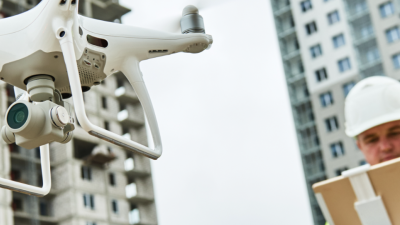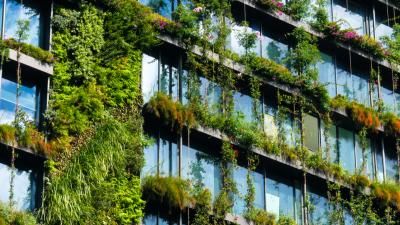
Discovering Safety and Safetytech Accelerator receive government funding
Discovering Safety and Safetytech Accelerator have been awarded Government funding for new project ‘Enabling Innovation in Industrial SafetyTECH’.
This page is approximately a 7 minute read
This page was published on

Infrastructure plays a central role in achieving 92% of the Sustainable Development Goals’ targets
Global conversations on tackling climate change understandably focus on reducing greenhouse gas emissions. But this is not the whole picture. If humanity is to continue to thrive in a changing climate, we need to build resilient and sustainable infrastructure that can adapt to future changes to the environment and society.
This includes not only building cities that can withstand future shocks and stresses, but also restoring and protecting the environment on which cities depend. This is true all over the world, but especially where there are large development gaps and old technology can be leapfrogged with better solutions.
Samantha Stratton-Short is Head of the Strategic Initiatives, Infrastructure and Project Management at The United Nations Office for Project Services (UNOPS). The organisation aims to “help people build better lives and countries achieve peace and sustainable development”, which includes helping them respond to the urgent climate crisis.
She explains, “Infrastructure plays a central role in achieving 92% of the Sustainable Development Goals’ targets. However, there is a substantial gap in infrastructure service provision, especially in the Global South, in terms of water supply, toilets, schools, hospitals, and other services.”
Over the years, much focus has been on built infrastructure; however, there is a growing recognition of the importance of nature-based solutions, says Stratton-Short. “In the engineering context this is often referred to as green-blue infrastructure, in contrast to ‘grey’ infrastructure made primarily of concrete and steel,” she said.
About 90% of disasters in the world are water-related and natural ecosystems can help build resilience to the impacts of these hazard events. Incorporating natural floodplains in public landscapes to collect water during heavy rainfalls can minimise flooding of built areas. In some applications, these can also be used as a natural way to clean or filter water.
Wetlands can also be effective in managing nutrient run-off and pollution from floods, as well as preventing drought. In northern Sri Lanka, UNOPS carried out hydrological studies and flood mapping in 2018, as part of a project to improve the network of drainage canals and natural ponds in townships. As a result, floodwaters now collect in the ponds rather than people’s gardens.
Other solutions include the use of green roofs or permeable paving to allow rainfall to permeate into the ground underlying urban areas. Rainfall can thus be used by people in buildings, or to feed vegetation or natural aquifers. This can also reduce the demand on inadequate sewer and drainage systems that were not designed for the current intense rainfall levels, which will worsen in the future if climate change is not curbed.
To date, such solutions are often small-scale. But it is expected that this will change by 2040, and water and other natural systems will be fully integrated into our built environment.
One ambitious project that attempts to take this approach to scale is happening in Shanghai, the largest urban area in the world, and home to 24 million people. Low lying and with a high water table, Shanghai is vulnerable to flooding, a situation worsened by the recent expansion of built-up areas surfaced with impermeable materials. A typhoon that hit the city in 2005 brought 153 mm of rainfall in 24 hours, causing economic losses equivalent to £1.5 billion. The Shanghai Urban Construction Design and Research Institute has devised a plan to turn Shanghai into a “sponge city” by 2030, using the nature-based techniques described above, as well as hydraulically-controlled urban rivers and canals.
Many of the environmental issues we are facing today are derived from a loss of biodiversity and natural habitats. For instance, deforestation has led to more severe flooding, landslides and soil degradation. Forests and peatlands are also critical carbon sinks, an important measure for climate mitigation. It is therefore important that vegetation is integrated into most of our future infrastructure.
Pakistan instituted an ambitious project aimed at ecosystem restoration in 2019. Supported by the UN Environment Programme, the Ten Billion Tree Tsunami project aims to plant 10 billion trees – hence the name – by 2029. The project aims to reduce the country’s vulnerability to climate change – important since it’s five percent forest cover (against a global average of 31 percent) and the powerful influence of the Himalayas on weather make it susceptible to monsoon, floods and droughts.
At a different scale, the city authorities in Karachi, Pakistan, are using the “Miyawaki method” of establishing small areas of biodiverse forestry with layers of shrubs, small and tall trees on urban plots of at least 93 square metres in area, with a density of two to four trees per square metre. Such plots can grow to maturity ten times faster than conventional plantations and dramatically increase biodiversity. Karachi currently has five of such forest plots.
“There is increased awareness on the importance of planting trees to reduce the urban heat island effect, which is a major issue in the Global South,” Stratton-Short said. “Reforestation also helps improve air quality. Nature has a lot to give if it is deployed thoughtfully.”
Restoring mangroves is another area of growing interest despite the difficulties. Mangroves provide benefits for local communities, biodiversity, and important protection from wind and storm surges. In India, the recently restored mangrove on the East Coast of Tamil Nadu, mediated the wind velocity of Cyclone Gaja in 2018, largely saving the town of Muthupet from significant damage.
Future infrastructure needs must increasingly be met by natural resources and domestic human resources in order to apply technology appropriate to the country’s context. Using locally sourced and fabricated materials is also key to sustainable construction solutions.
For example, MASS Design Group designed a concrete frame infilled with compressed stabilized earth blocks (CSEB) fabricated on site, with a light-colored clay brick facade, used in the construction of the African Leadership University, located in Kigali, Rwanda. In Entebbe, Uganda, the Italian architect Renzo Piano, designed a children’s hospital built from rammed earth compressed into wooden molds, with all materials and the workforce sourced locally. These projects used and trained local craftspeople.
New building materials – both high- and low-tech – are also in UNOPS’ plans. 3D printing using concrete – or even composites incorporating natural materials – is gathering attention.
‘14 Trees’, a joint venture with CDC Group and LaFargeHolcim is printing houses and schools in Malawi and Kenya. This increases the speed of construction and reduces carbon by as much as 70%.
Transport is also critical to resilient sustainable cities. Due to poor planning and enforcement, many cities are sprawling and have limited public transportation, making traffic congestion a persistent problem. This contributes to dangerous levels of greenhouse gas emissions as well as poor air quality that damages human health. “Electric vehicles and better public transport are important parts of transport solutions”, Stratton-Short says. By 2040, we should see cities dominated by integrated multimodal green transport systems.
In Asian cities built around many watercourses, such as Bangkok and Manila, there is an opportunity to ramp up sustainable ferry (or water bus) services and connect these to electric train and bus services, as well as passive transport including protected bicycle lanes. This creates what Stratton-Short calls “integrated, green, resilient transport systems”. In Manila, she added, private local ferry services have largely disappeared, but as long as waterways are progressively cleaned, there is an opportunity to use them to improve both public amenities and transport flows.
These are non-exhaustive options for future resilient and sustainable infrastructure solutions. There is never going to be a “one size fits all” approach, Stratton-Short stresses; in every case, there will be specific problems that need to be overcome.
In resource-poor regions of the world, where large numbers of people are likely to be affected by climate change, an integrated approach drawing on the full array of available solutions will be needed over the coming decades. These need to be focused on how we work with nature, bring back natural ecosystems services, and how we support the planet to flourish again so that in turn, it can support our evolving needs against an uncertain future.
“One advantage many places in the Global South have is that they can jump ahead,” she concludes. “They are not held back by having to address ageing legacy systems. With the right strategic planning and large long-term investments, governments can build resilient and sustainable infrastructure that will improve the quality of life of individuals, whilst preparing societies for a climate that will be very different in 20 years’ time.”